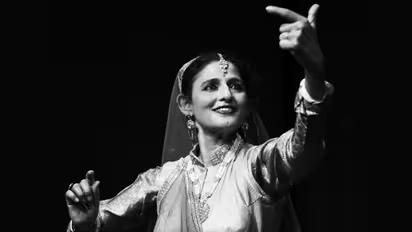Enhancing Museum Experience with Navina Jafa – Dancing Sculptures

Synopsis
In the two hours walk around the galleries, Dr Navina Jafa took the small group of visitors into another world where she chose to interpret sculptures and paintings to provide a multidimensional understanding of Indian dance and their association with visual arts.
Dr Navina Jafa, a well-known expert on cultural Heritage, Kathak dancer, and scholar, recently organised a heritage walk at the National Museum, New Delhi, on the upcoming International Museum Day on 18th May. The Museum walk was on Indian Dance and Visual Arts.
Jafa's association with the National Museum goes back many decades before, when she gave lectures and dance performances as part of the art appreciation series at the museum. Navina also curated more than hundred and fifty interactive lectures titled 'Window to Indian Arts' at the Alliance Francaise de Delhi, connecting Indian performing arts with visual Arts. It was a programme attended by more than 500 diplomats and corporate members during the 1990s and early 2000s.
Navina Jafa opened the museum walk by stating the intention. She quoted Sidney Dillon Ripley, Secretary of the Smithsonian, the largest museum in the world in Washington, DC. "During my tenure as a Fulbright Scholar at the Smithsonian, I learned that Ripley emphasised that curators should focus on enhancing the visitor's experience to 'take the objects out of their cases and make them sing."
In the two hours walk around the galleries, Navina Jafa took the small group of visitors into another world where she chose to interpret sculptures and paintings to provide a multidimensional understanding of Indian dance and their association with visual arts. To delight the audience, Jafa danced to emphasise the connection of Indian dance tradition with the artefacts.
The highlight of the heritage walk was Jafa's presentation of the iconic tiny bronze sculpture titled 'Mohenjo Daro Dancing Girl'. John Marshal, Director General, director general of the Archaeological Survey of India, gave the name to the exquisite masterpiece of Indian art. Jafa began her commentary on the sculpture by informing about the basic facts and then developed the heritage interpretative theatre on the object.
"Even though there are disparate views on whether or not this stunning young girl is dancing, I prefer to believe that she is dancing. Dr Kapila Vatsyayan, dance and art historian, referred to the sculpture as one of the most important pieces of evidence on nuances that came to feature in the pan-Indian dance tradition recorded in the Natya Shastra, the seminal text on Indian dance," said Jafa.
Navina Jafa continued to point out that the nude body allowed the viewer, especially those engaged in the Indian dance, to relate to the representation and treatment of the body. The dignity and grace of the way the artist portrayed the body. The provocative curved spine, the bent knee, and the arm on the hip communicated so many dynamic aspects that different dancers can see, register and learn. "This is why those engaged with dance need to connect with museum objects and build heritage sites," said Jafa.
The commentary on the dancing girl further pointed to other implications of the sculpture. Said Jafa, "Contextualising a lone museum figure is challenging, and yet the interpretation can relate an object to many subjects. The bronze sculpture of the Mohenjadaro dancing girl is about the Heritage of metal art, namely the 'lost wax' technique. She is also important from the point of view of gender archaeology. The dancing girl stands boldly, nude, with one arm filled with bangles and a necklace. The sculptor seeks to communicate the shringara rasa (aesthetic delight of the idea of beauty) and celebrates the visibility and equity of feminine power.
Third, the bronze sculpture is also an important entry point in creating links between dance traditions in different parts of Asia. In my report for the Ministry of Culture, Government of India, as part of the Junior Fellowship, I highlighted the antecedents of Kathak with West and Central Asian dance traditions. As part of soft cultural diplomacy, there can be an interesting cross-cultural dialogue between different subject experts such as artists, art historians and dancers."
Jafa then referred to her work as the honorary convenor on Heritage Education at the Central Board of Secondary Education (CBSE). "In the number of reports on my workshops ( in Delhi NCR, Kashmir, Jharkhand, Maharashtra, Haryana) where I trained school teachers to formulate multidisciplinary learning through heritage education, the idea was to create the potential of heritage objects and heritage landscapes that could contribute to the education of different subjects. Museum objects like this sculpture provide so much educational potential for young minds."
Navina Jafa briefly mentioned Artificial Intelligence's importance and challenges in dance and museum displays. "Just a few months ago, the Department of Archaeology, Cambridge Heritage Research Centre, invited me to develop codes to interpret some Asian sculptures in different museums. The intention was to increase the emotive context of the iconographical artefacts. AI allows for a multilevel approach to museum objects, but in my view, the human factor to actually make the museum pieces 'perform' is irreplicable, and this was the intention of the walk," expressed Jafa.
Even though India has such a rich repository of Heritage and museums, visiting museums in India is not high on the list of Indians travelling from one place to another. One of the main reasons said Jafa was that while setting up museums, there needs to be more research and surveys conducted to understand the minds of audiences/consumers. To increase the footfalls, the museums' subject and outreach programs must be attractive and tastefully presented. It is a challenge to grapple with an inanimate object and present that past to the visitor who stands to assess, access and interpret from the standpoint of the present. Multiple kinds of cultural professionals are required to make the Heritage and the museums of India 'performed'.